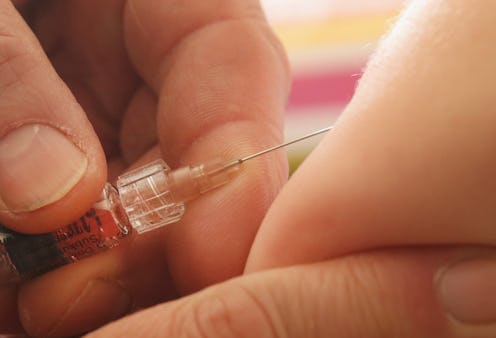News
Rates Of Unvaccinated Kids Rose — But Anti-Vaxxers Aren't The Only Reason Why

A new report from the Centers for Disease Control and Prevention shows that vaccination rates are down slightly among children aged 19 to 35 months. But parents actively against vaccinating their children — called "anti-vaxxers" by some — may not be solely to blame, the report shows. Young mothers and fathers' getting their children access to healthcare and insurance coverage may be key in reversing this trend.
The CDC's Morbidity and Mortality Weekly Report (MMWR), released on Friday, included the study on vaccination coverage. In general, the numbers "remained high and stable overall," the report reads, with an overall coverage rate of 90 percent nationwide. The vaccinations they looked at should be administered by 24 months and fight against 14 potentially serious illnesses — among them measles, mumps, rubella, polio, and hepatitis B.
The number of children who had not been vaccinated at all by 24 months was "low," the CDC report reads, but has increased. The non-vaccination rates range from 0.9 percent for children born in 2011 to 1.3 percent for children born in 2015 — those are the youngest kids that the study covered, as they would have turned 24 months (or two years) when the study was carried out last year.
The study did not survey why young moms and dads chose not to vaccinate their children, though it did comment on the various factors. "Some children might be unvaccinated because of choices made by parents, whereas for others, lack of access to health care or health insurance might be factors," the report reads. It noted that "continued evaluation of prevalence and reasons for nonvaccination is needed."
There are some clues, though, in this report. Some of the data that the report stressed the most was where children lived — whether in a city or rural area — and if they had private insurance coverage or not. The report underlined that a relatively high percentage of unvaccinated children were uninsured — 17.2 percent compared to 2.8 percent of all children.
Rural children were more likely not to be vaccinated, too. The rate of children not vaccinated is almost double in rural areas, 1.9 percent, compared to cities, at 1.0 percent.
Rates of non-vaccination separated by insurance coverage present big differences, though. Private insured children have the lowest rate, at 0.8 percent. Medicaid is a bit higher at 1.0 percent unvaccinated. For uninsured children, the rate soars to 7.1 percent. The report calls this discrepancy "concerning," especially given the existence of a government program, Vaccines for Children, which offers free vaccinations to families that need them.
For both the uninsured and rural children, however, accessing this program could be difficult. "Lack of geographic proximity to vaccination providers, including those who participate in the VFC program, can be a barrier to vaccination," the report reads. "The shortage of health care providers, especially pediatricians, might partially explain the lower coverage among children living in rural areas."
As for uninsured children, it's likely the parents' lack of knowledge about the program is why they haven't used the services. "Unfamiliarity with the VFC program and how to access it, transportation, child care, and convenience of clinic hours might also need to be addressed," the report reads.
If you're a young parent and want more information about how to vaccinate your child, check the CDC's Q&A on where to go, how much it will cost, and more.